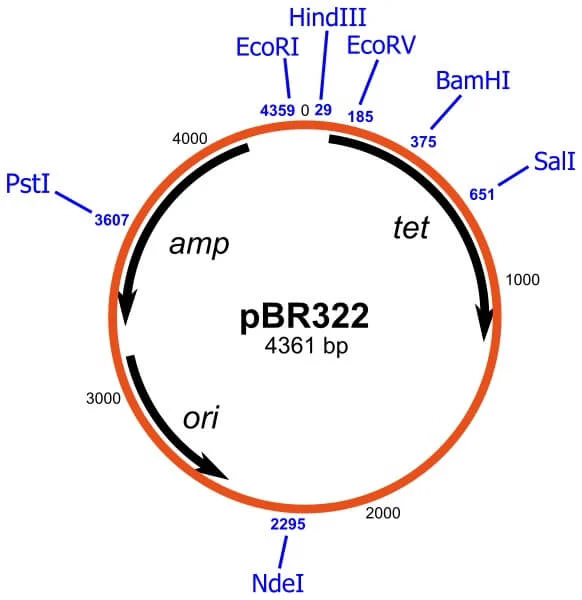Introduction:
pBR322 is a commonly used cloning vector in E. coli and has tremendous applications in cloning.
pBR322 full form,
p = plasmid
BR = Bolivar, and Rodriguez
322 = numerical designation
It was constructed in 1977 in the lab of Herbert Boyer at The University of California in San Francisco.
It is a synthetic plasmid and was the first artificial plasmid to be constructed and used as a cloning vector.
pBR322 is one of the most studied plasmids.
It is 4362 base pairs long.
It is completely sequenced, which means the whole sequence of pBR322 is known and studied.
Its molecular weight is 2.83 x 106 Daltons.
Structure of pBR322:
1.Origin of replication
2.Restriction enzyme sites
3.Selectable marker sites
1.Origin of replication
The origin of replication in plasmid pBR322 is known as pMB1.
The copy number of this plasmid is 15-20.
2.Restriction enzyme sites
Around 40 different restriction sites are present on the genome of pBR322.
Almost 11 different restriction sites are present in the region of tetracycline resistance region.
In the ampicillin resistance region 9 restriction sites of different enzymes are present.
Some of the known restriction enzyme sites are – BamHI, HindIII, EcoRI, SaII, and many more.
3.Selectable marker sites
Two selectable marker sites or antibiotic resistance genes are present on the genome of this plasmid.
Ampicillin resistance site – the ampicillin gene codes for β-lactamase, which can be used for screening microorganisms when a foreign DNA is being inserted in the plasmid.
Tetracycline resistance site – this gene degrades the antibiotic tetracycline and can be used for screening microorganisms.
These antibiotic resistance genes are useful in screening organisms after cloning.
Screening of recombinants containing pBR322:
Consider that the restriction enzyme BamHI is used to cut the plasmid at that specific position.
BamHI lies in the tetracycline resistance region of plasmid pBR322.
Now, the recombinant molecule of pBR322, which includes the newly inserted DNA molecule, will be sensitive to Tetracycline.
But this recombinant molecule is resistant to Ampicillin, as the ampicillin resistance gene is fully functional.
Hence, when the recombinant cells are plated on the medium containing ampicillin and incubated.
The colonies that appear on plates containing a medium with ampicillin are transformed colonies containing cells with the newly inserted DNA molecule.
The replica plate technique is used to confirm the transformed colonies.
To confirm that the colonies on the ampicillin-containing media are transformed colonies, they are plated on the plates containing a medium inclusive of tetracycline.
The colonies that do not grow on the medium inclusive of tetracycline are transformed colonies as the transformed colonies are sensitive to tetracycline.
Advantages of pBR322:
Due to its manageable size, plasmid pBR322 is widely used as a cloning vector.
The presence of two antibiotic resistance genes eases the selection process of recombinants.
Multiple restriction enzyme sites make the plasmid compatible in many ways.
It has a high copy number which is highly favorable in genetic engineering.
Disadvantages of pBR322:
Detection of recombinant cells having the newly inserted DNA molecule is time-consuming.





